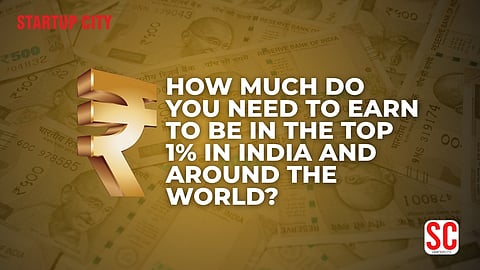

When people talk about being part of the top 1%, it often sounds like an elusive club reserved for tycoons and billionaires. But what does it actually take to be in that elite bracket, especially if you're living in India?
Well, the short answer is: a lot. But how much exactly depends on where you live, how the cost of living is structured in your country, and what metric you use, income or wealth.
Let’s break this down in detail, starting with India and expanding our view globally.
Being in the top 1% doesn’t just mean you’re doing well, it means you earn more than 99 out of 100 people around you. It’s a statistical benchmark that gives a snapshot of income distribution. Economists and policy-makers often use this figure to discuss income inequality and taxation, but for individuals, it’s often a symbol of financial success.
The top 1% is calculated based on annual income, but there's also a similar classification for wealth (your total net worth including savings, property, investments, etc.).
In India, you’d need to earn around ₹50 lakh (₹5 million) per year or more to be considered among the top 1% of income earners, according to various reports and estimates from the Income Tax Department and credit agencies. That breaks down to roughly ₹4.2 lakh per month.
If you're earning between ₹10–20 lakh annually in a metro city like Mumbai or Bengaluru, you might live a fairly affluent lifestyle, but you’re still outside the top 1%.
Here's a quick breakdown of income tiers in India:
Top 1%: ₹50 lakh+ per year
Top 5%: ₹20–50 lakh per year
Top 10%: ₹12–20 lakh per year
Average Indian: ₹1.5–2 lakh per year (according to NSSO data)
These figures reflect taxable income and may vary depending on sources and inflation-adjusted calculations.
So, what kind of career path can realistically take you into the top 1% in India? Here are a few high-earning roles that can help you cross that income bracket:
Senior Tech Executives: If you're a VP or C-level executive in a major IT firm or startup, annual pay packages often start from ₹50 lakh and go into crores.
Bollywood & Entertainment: Leading actors, directors, and producers can earn well above ₹1 crore per year.
Investment Bankers and Fund Managers: Top-level roles in finance can easily push you past the ₹1 crore mark.
Consulting Partners in Big Four Firms: Partners at EY, Deloitte, PwC, or KPMG often earn ₹60–80 lakh and above.
The concept of being in the top 1% is closely tied to the broader issue of income inequality. According to Oxfam, the top 1% of Indians now own more than 40% of the country’s wealth, while the bottom 50% share just 3%.
Over the past two decades, this gap has widened. High-income earners have seen faster growth in their wealth and income, while the majority have had relatively stagnant or slow-moving upward mobility.
This disparity isn't just about luxury and lifestyle, it impacts access to quality education, healthcare, and opportunities.
Let’s compare India’s top 1% with a few other major countries to give you a global perspective:
Top 1% Income: Around $500,000 to $1 million per year, depending on the state.
In cities like New York or San Francisco, you may need more than $1 million to make the cut.
Top 1% Income: £170,000+ per year
In regions outside London, around £60,000 can still buy you a very comfortable life.
Top 1% Income: AUD 250,000+ annually
Tech and mining industries are key wealth generators here.
Top 1% Income: €150,000+ per year
Engineering, pharmaceuticals, and finance are major sources of high incomes.
Top 1% Income: AED 1,000,000 (~₹2.25 crore) per year
Oil & gas, finance, and real estate dominate the high-income bracket.
Top 1% Income: SGD 300,000 (~₹1.85 crore) per year
Financial services, tech, and medical fields are leading industries.
As you can see, the bar to be in the top 1% varies significantly by country, largely depending on cost of living, economic development, and tax structures.
A quick but important distinction: income is what you earn, but wealth is what you own.
Someone making ₹1 crore a year but spending most of it might not be as financially secure as someone earning ₹25 lakh a year but sitting on ₹10 crore worth of real estate and investments.
In wealth distribution studies, India’s top 1% hold a disproportionately large share of national wealth. So being rich isn’t always about earning more, it’s also about saving, investing, and owning appreciating assets.
As of 2025, there are 3,028 billionaires worldwide. The top 3 richest people? Elon Musk, Mark Zuckerberg, and Jeff Bezos. In India, names like Mukesh Ambani and Gautam Adani continue to dominate the ultra-rich list.
In terms of countries:
USA: 902 billionaires
China (including Hong Kong): 516
India: 205 billionaires
The global rich list is growing each year, but only a tiny percentage of humanity actually makes it into this bracket.
If your goal is to break into that upper echelon, here are a few tips that could help:
Choose the right career path: High-paying fields like tech, finance, medicine, and consulting have better earning potential.
Invest early: Use compounding to your advantage. Mutual funds, stocks, and property can grow wealth far beyond your salary.
Upskill continuously: As the market evolves, skills in AI, data analytics, and digital transformation can open doors to premium roles.
Network smartly: Many top-paying opportunities come from strong professional relationships and insider referrals.
In India, you need to earn at least ₹50 lakh a year to be part of the top 1%, while in countries like the US, that threshold is $500,000 or more. The exact number varies, but the principle remains the same: getting to the top requires strategy, skill, and smart financial planning.
If you're aiming to reach that level, it's not just about working harder—it’s about working smarter, investing wisely, and making informed choices that align with your financial goals.